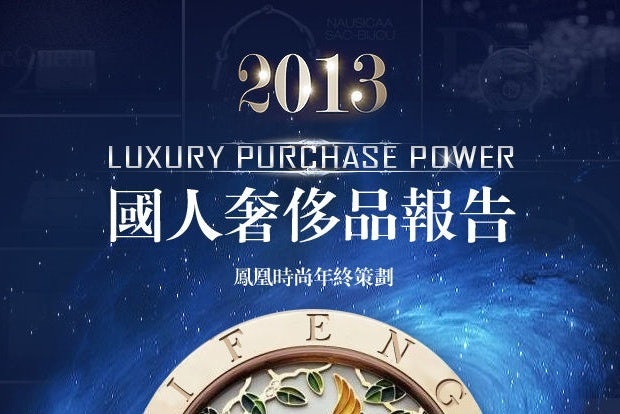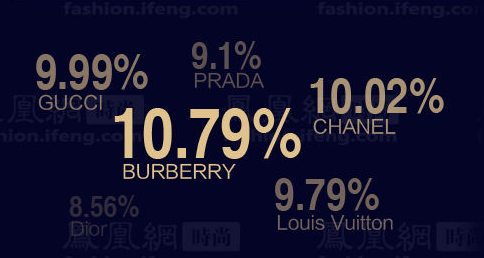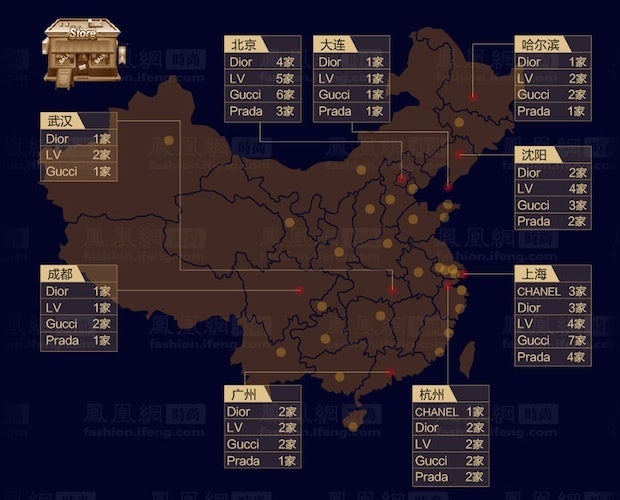
In 2013, middle-class Chinese luxury consumers preferred to buy their items abroad and chose Burberry as their favorite brand.
The results of a new “Luxury Purchase Power” survey by Chinese news site iFeng delivers a comprehensive report on the preferences of China’s luxury consumers in 2013, including what items they were buying, where they were buying them, how they were using them, and more. The survey is in Chinese, but if you can’t read it, don’t worry: we have an overview for you here.
From the survey, it’s clear that Chinese consumers still love luxury goods: 76.74 percent of respondents said that they’d bought luxury products in the last year. The answers came from a solidly middle-class answer pool, with an income range of 5,000 to 20,000 RMB a month, (US$826 to $3,304). The majority of respondents (46.32 percent) believed that “luxury items” were defined as costing upwards of 10,000 RMB, while 26.96 percent considered the definition to be between 5,000 and 10,000, and 20.53 percent believed 2,000 to 5,000 RMB constituted luxury. The majority (45.97 percent) said they spent equivalent to one month’s salary on luxury shopping.
This year, Burberry topped the list of favorite brands and was followed closely by Chanel, with Gucci, Louis Vuitton, Prada, and Dior trailing behind. This reflects overall trends in growth numbers this year: Burberry has seen a healthy China rebound, while Louis Vuitton has struggled with slowing numbers. Handbags were the dominant category for purchases, followed by clothing, jewelry, shoes, and cosmetics, respectively.

Secondhand goods, fakes, and logos are all out of style, according to the survey. To the likely chagrin of vintage shops, buying secondhand still isn’t fully acceptable: less than 5 percent said they bought used items this year, and 51 percent said they don't like them. Meanwhile, a full 74 percent of respondents said they didn’t buy fakes this year. The no-logo trend we’ve been seeing was also confirmed by the survey: 44.19 percent said they would avoid logo products, while 35.73 percent said they wouldn't necessarily avoid logos, but their most important consideration was the quality of the item. Logos aren’t completely dead, however: 20.08 percent still take them as a main purchase consideration.
When it comes to where they’re buying the goods, the majority unsurprisingly said they’re heading abroad: 40.52 percent said they bought goods shopping overseas. Meanwhile, 37.47 percent said they bought in dedicated boutiques. The daigou option of buying from dealers who had purchased abroad wasn't as prominent as one would think: only 8.6 percent bought using this method, and an even smaller 5.92 percent bought online.
Of those who bought goods in-store, 43.13 percent said they bought internationally, while 24.89 percent said they bought in Hong Kong and 31.98 percent said they bought on the mainland. These results roughly coincide with the previous estimate that 60 percent of luxury goods are purchased outside the mainland, and implies that the number is rising.
The survey also provides a map of store distributions by luxury brand. First-tier cities Beijing and Shanghai still dominate the country with the highest concentration of brands’ boutiques, while first-tier Guangzhou and second-tier cities tend to only have one or two boutiques per brand. The notable exception is Shenyang, which has four Louis Vuitton stores and three Gucci locations.

According to user comments on the survey, attitudes are continuing to shift against ostentatious luxury. One user states, "Buying expensive items for yourself isn’t right. It’s intrinsically wrong: a sign of vanity and lack of taste for women who want to save face, hypocrites, and tuhao (a disparaging term for China’s nouveau riche)." Meanwhile, another comment argues that China's luxury goods boom is due to gray income, corruption, a stock market slump, a rise in "debauchery," and lack of faith that donating to charities isn't a scam.
If you can read Chinese, the full infographic of the survey is below.
